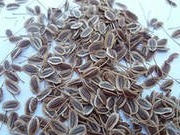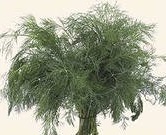Dill is an annual plant of the umbrella family. All its ground parts, especially seeds, have a pleasant aroma due to the content of essential oil. For food use young dill (in the presence of 6-10 leaves) or individual leaves from older plants. In addition to essential oil, its leaves contain vitamin C, carotene, vitamins B1, B2, PP, E and organic acids. They are used both fresh and harvested for the winter - they are salted, frozen or dried (although salted dill loses its valuable qualities).
Greens and dill seeds are used not only as a spice, but also as a medicine (they reduce high blood pressure, improve appetite and digestion, the work of the gastrointestinal tract, calm the nervous system).

OPTIMAL CONDITIONS
Temperature and Light
Dill belongs to cold-resistant plants, tolerates low temperatures and small frosts. Seeds begin to germinate at 3ºС, however, at this temperature, germination lasts a very long time (sometimes up to a month). Slow germination of dill seeds is associated with a high content of essential oil. Therefore, to obtain fast and friendly seedlings, it is necessary to carry out pre-sowing treatment. Optimal for plant growth is a temperature of 15 ... 20ºС. It should be borne in mind that dill is a photophilous culture.
Soil and moisture
Dill does not impose special requirements on soil fertility, it may be enough fertilizers introduced under the previous culture. However, a high yield can only be learned in fertile, water-intensive soils (dill is water-loving). When the soil is overdried, the yield decreases, plants quickly proceed to the formation of the stem. Such dill is not in demand in the market (amateur vegetable growers can pick off individual leaves from them for use in food or leave the plants to form seeds).
SELECTION OF VARIETIES
Unlike other crops, such as tomato, pepper, cucumber, dill varieties are not so visually different from each other. Basically - the intensity of the green color of the leaf and wax coating; less obvious, but no less valuable features are aromatic leaves and their taste. In addition, dill varieties are divided into early, mid-ripening and late ripening.
Early varieties (for example, Gribovsky) are suitable for harvesting on greens about 10 days earlier than late-ripening. However, they are usually less leafy and have less plant mass. Another disadvantage of early ripening varieties when grown on herbs is the short period of economic shelf life. This means that the plants quickly form the stem and, when they are late or delayed in harvesting, lose their marketability (therefore, it is important to remove them on time). These varieties manage to give a good crop of seeds in the middle lane, which are widely used in the food industry. Therefore, the early varieties of dill are used for growing early herbs in film greenhouses and open ground, as well as for growing seeds.
Late-ripening varieties are more leafy, characterized by a larger mass of one plant. After being ready for harvesting on greens, they can be removed within 2 weeks, since all this time they remain in the outlet phase. Late-ripening varieties are used for sowing in May - June and harvesting in the summer months. These include varieties such as Kibray, Tetra.
Recently, the so-called varieties of bush type. These are late-ripening varieties, the seeds of which often do not have time to ripen in the middle lane, therefore they are engaged in seed production in the southern regions. A characteristic feature of bush varieties is a very slow stem formation. In the axils of the leaves, they form lateral shoots, so the plant looks like a whole bush.
However, all the typical characteristics of plants of bush varieties can show only under the important condition - a large area of nutrition. Between rows and between plants in a row there should be a minimum of 15 cm. With the usual density of standing, lateral shoots of bush varieties do not grow, although even under these conditions they form a stem later than ordinary varieties. Therefore, when sowing such varieties of row-spacings, they should be 20–30 cm, and the distance between plants in the row after thinning (removed plants are used for greens) should be 15–20 cm. With this sowing scheme, plants begin to form a peduncle only by mid-July. Thus, for about 1.5 months, they can pluck leaves on the greens. Such varieties are of particular value for amateur vegetable growers, since they reduce the number of dill crops during the season. Shrub varieties are used for sowing in the spring in the open field.
Shrub varieties are: Russian size, Salute. The Gourmet variety, which belongs to the bush, also has very tasty aromatic greens.


GROWING FOR OWN NEEDS
Better sow several times
In order for the young dill greens to be on your table all summer, you must remember to carry out multiple crops, sowing, for example, 1 bag of seeds each time. In this case, fresh young leaves can be harvested from May to October. Schematically, the sowing dates for the middle band look like this:
1) winter sowing to obtain the earliest harvest in the spring, is carried out in the second half of October - early November;
2) early spring sowing to collect greens in early summer, is carried out in April, as soon as the soil is dry, and it can be processed;
3) from May to early August, repeated sowing is carried out with an interval of 2-3 weeks; in this case, greens will come from the second half of June until mid-October.
How to get friendly shoots
Growing dill on a personal plot is quite simple. The only thing that causes difficulty (especially for novice growers) is getting seedlings. In order not to face this problem, many summer residents in autumn, seeds are collected from abandoned seed plants and scattered around the site. With this method of “winter” sowing, the seeds in the spring swell well and germinate early. The big minus of this sowing is that during spring tillage at the site next year you destroy young dill seedlings, so you have to wait for the second wave of seedlings, which delays the flow of greens. In addition, dill grows in beds with other (main) crops, and when weeding them, you need to be especially careful not to pull out dill plants.All this causes certain difficulties, so it is better to allocate separate small sections under dill.
To accelerate the germination of dill seeds and obtain guaranteed seedlings, it is necessary to carry out their pre-sowing treatment. There are 2 main ways. The first is bubbling (soaking seeds in water that is constantly saturated with oxygen), in home For this, you can use an aquarium compressor. Sparging is carried out at a temperature of 20 ° C for 18–20 hours, during which time some seeds begin to peck, so they are sown as a slice. The second method is soaking in water for 2-3 days. During soaking, water is changed every 6–8 hours. Prepared for sowing seeds are sown only in moist soil.
Sowing by the rules
On dachas and household plots for dill, as a rule, do not make organic or mineral fertilizers. Before sowing (except for winter), grooves must be watered. At the bottom of a wet groove, seeds are sown and sealed on top with dry soil from the edges. With this method, the seeds fall on moist soil, and the soil crust does not form on top. Sown in rows, which facilitates further care. When growing dill on greens, the distance between the rows should be 10–15 cm, and when growing on seeds - 20–30 cm. The sowing depth is 1–2 cm, depending on the type of soil. The seeding rate is 2-3 g / m² (or 1 g when grown on seeds).
Plant care
Caring for dill plants is reduced only to weeding and loosening row spacings. To prevent the plot from overgrowing with weeds, the aisles are loosened approximately once a week.
Harvest
Harvesting of greens begins approximately 30-40 days after sowing, starting to eat young plants about 5 cm high. Harvesting can be carried out either selectively, pulling out the largest plants, or solid, pulling everything out.
If you are late with harvesting, when the dill reaches 15–20 cm in height, it is advisable to remove all the plants and put them to processing. Otherwise, they quickly form inflorescences, losing their taste (in adult plants, the leaves are more rigid and coarse). A small number of plants from spring sowing can be left: inflorescences can be used either in the summer for canning or pickling vegetables, or in the autumn for collecting seeds.
GROWING FOR IMPLEMENTATION
Maximum profit
When growing dill for sale, the main attention is paid to obtaining the maximum yield in spring and autumn, when the market price for greens is the highest. For early production use film greenhouses, simple film shelters. One of the most cost-effective is growing dill in film greenhouses with early spring planting.
Recommended Cultural Revolutions
In central Russia, the following culture revolutions can be used.
For film greenhouses with air heating
1) March 5–15 - sowing of dill, harvesting - April 20–25;
2) April 30 - August 10 - cucumber, early tomato (planting seedlings);
3) August 15 - October 15 - dill.
To use the film greenhouse from March to October, you need to use a reinforced film, which also serves for 3-4 years, if you remove it from the roof for the winter.
For film greenhouses on solar heating and the simplest film shelters
1) April 1–10 - sowing dill, May 10–20 - harvesting;
2) from May 20 to September 20 - cucumber, tomato, pepper, eggplant (planting seedlings).
In the fall, the period of greenery supply can be extended even in the absence of a greenhouse using cover materials. In this case, dill is sown in early August on areas freed from early vegetable crops (early potatoes, early white and cauliflower, onions, garlic, etc.). When cooling in late September, ridges with plants are covered with covering materials, protecting them from frost.Harvesting is carried out in the first half of October, and during warm autumn - until the end of October, when the price of greens rises.
Sowing Features
When growing dill for commercial purposes, only seeds that have been pre-sowed are used to speed up the harvest. In film greenhouses and shelters, you can use a horizontal or continuous sowing scheme, but continuous sowing is considered the most profitable. At the same time, a track 40 cm wide is left in the center of the greenhouse for passage, the rest of the area is sown (seeding rate - 15 g / m²).
Outdoor cultivation
When grown in open ground, the maximum green yield (up to 26 t / ha) can be obtained on light fertile and slightly clogged soils. It is best to grow dill on greens after crops under which manure was applied (cabbage, cucumber). 200-300 kg / ha of ammonium nitrate and 100-150 kg / ha of superphosphate and potassium chloride are added under pre-sowing tillage. The seeding rate for continuous sowing on light soils is 70–80 kg / ha, on heavy soils - 40–60 kg / ha.
Crop care consists of 2-3 irrigation, if necessary - one fertilizing with nitrogen fertilizers. Harvesting dill on greens is carried out in the morning and immediately transported under a canopy or in the refrigerator.
After harvesting, you can again sow dill in the same field. With good agricultural technology for the season, you can spend up to 3 crops in the same area.
